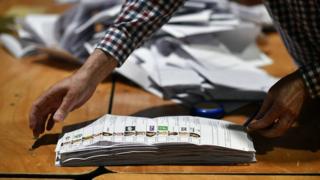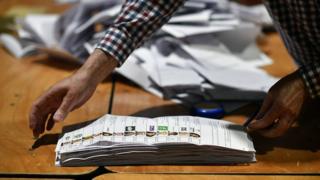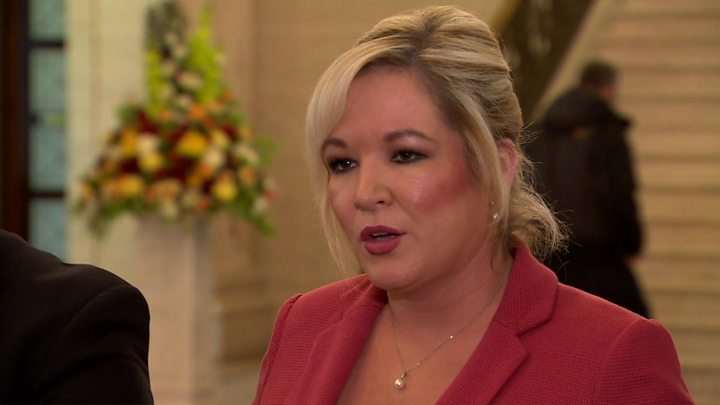Irish general election: Sinn Féin surges as half of seats filled
The left-wing republican party’s vote is up, but it is not clear how a government will take shape. …

 Image copyright Getty Images
Image copyright Getty Images More than half of the seats at stake in the Irish general election have been filled, following what has been a historic result for Sinn Féin.
The outcome was described as “something of a revolution in the ballot box” by the party’s leader Mary Lou McDonald.
With all first preferences counted, the left-wing republican party has taken 24.5% of the vote, compared to 22% for Fianna Fáil and 21% for Fine Gael.
No one party will win enough seats for an outright majority.
About 100 of the 160 seats have been declared, but negotiations to establish a government could be prolonged.
Before the election, both Fine Gael and Fianna Fáil had ruled out forging a coalition with left-wing republican party Sinn Féin, citing its tax policies and IRA past as deterrents.
On Sunday evening, taoiseach (Irish PM) and Fine Gael leader Leo Varadkar conceded it would be “challenging” to form a government.
Fianna Fáil leader Micheál Martin did not rule out working with Sinn Féin, but said “significant incompatibilities” still existed.
Sinn Féin President Mary Lou McDonald said she was exploring options to see if it would be possible to form a government without either Fine Gael or Fianna Fáil.
Ms McDonald, who topped the poll in her four-seat Dublin Central constituency, said: “The frustration people have felt for a long time with the two-party system, whereby Fine Gael and Fianna Fáil handed the baton of power between each other – that’s now over,” she said.
“This vote for Sinn Féin is for Sinn Féin to be in government… for Sinn Féin to deliver,” she told RTÉ’s Morning Ireland programme on Monday,
“My first job of work, and I commenced this yesterday, is to establish with other parties whether or not there are the numbers to deliver a government without Fianna Fáil or Fine Gael.”
Her party’s vice-president, Michelle O’Neill, said Sinn Féin would have “asks in terms of the republican project”, in line with its repeated calls for the next government to prepare for Irish unity.

Media playback is unsupported on your device
Outgoing Irish finance minister and Fine Gael TD Paschal Donohoe said his party was likely to have “some form of engagement” with Sinn Féin, but said the two parties would not be going into government together.
Why the Sinn Féin surge?
Left-leaning Sinn Féin managed to successfully tap into the public anger felt in the Republic of Ireland over issues that have dogged centre-right Fine Gael for a number of years – a shortage of housing, rocketing rents and homelessness, analysts suggest.
That is despite the fact the country is forecast to have one of the fastest growing economies in the EU in 2020.
They were dubbed “the problems of success” by former Finance Minister Michael Noonan as far back as 2015.
Brexit – a considerable focus of Leo Varadkar and his deputy Simon Coveney while in power – barely registered as an issue in the campaign.
Democratic Unionist Party (DUP) leader Arlene Foster, whose party is in a power-sharing government with Sinn Féin in Northern Ireland, said younger voters had backed Sinn Féin as a “protest vote”.
“From a Northern Ireland perspective we will have to work with whoever the government is in the Republic of Ireland,” Mrs Foster told BBC Radio Ulster’s Good Morning Ulster programme.
She also questioned whether Sinn Féin would have their focus on Northern Ireland questioned, in the way there had been a “wailing and gnashing of teeth” over her party’s confidence-and-supply agreement with the previous Conservative government in the UK.
All parties have thinking to do
Sinn Féin’s surprise success from day one of the election count shows no sign of stopping.
The party’s ability to position itself as the anti-establishment choice in this election has seen a raft of candidates elected in areas party strategists didn’t really think winnable.
New Sinn Féin Kildare South TD – Patricia Ryan – had gone on holiday during the campaign, so small did she think were her chances of taking a seat.
When the transfers have determined where the final seats go, the difficult work will begin.
After the last Irish general election in 2016, it took 70 days for a government to be formed because then, too, no single party won a majority.
The big three parties – as they now are – have thinking to do and phone conversations are already well under way about the shape of a new government.
Time – and possibly plenty of it – will tell.
Rise in seats
Sinn Féin has dramatically increased how many seats it holds after it won the most first preference votes, topping the poll in 30 of the 39 constituencies.
Media playback is unsupported on your device
Following the last election in 2016 Sinn Féin had 23 seats in the Dáil (Irish parliament).
Fine Gael has been in government since 2011, firstly with the Labour Party and then with independents and since 2016, a confidence-and-supply deal with Fianna Fáil.
It looks set to lose seats for the second election in a row, but that does not necessarily rule it out of forming another government.
Its share of first preference votes dropped from 25.5% at the last election to 20.9%.

Media playback is unsupported on your device
The taoiseach said he was “not really” disappointed that he did not top the poll in his own constituency. He did get an increase in his votes compared to the last election.
He added it was now clear there was now a “three-party system”.
On Sunday Micheál Martin said reports suggested his party “would be the largest” but that it was early days.
He said the most important thing when forming a government was “compatibility in the programme for government” and that formation of a government was going to be very difficult.
Mr Martin added he was a “democrat” and respected the will of the people.
What about the smaller parties?
The Green Party is also set to increase the number of seats it holds.
Green leader Eamon Ryan, who was elected on the first count for Dublin Bay South, said his party would play its part in talks to form a government.
The Green Party secured 7.1% of first preference votes, followed by Labour (4.4%), Social Democrats (2.9%), Solidarity-People Before Profit (2.6%).
Aontú (1.9%) independents (12.2%) and others (1.3%) accounted for the rest.




